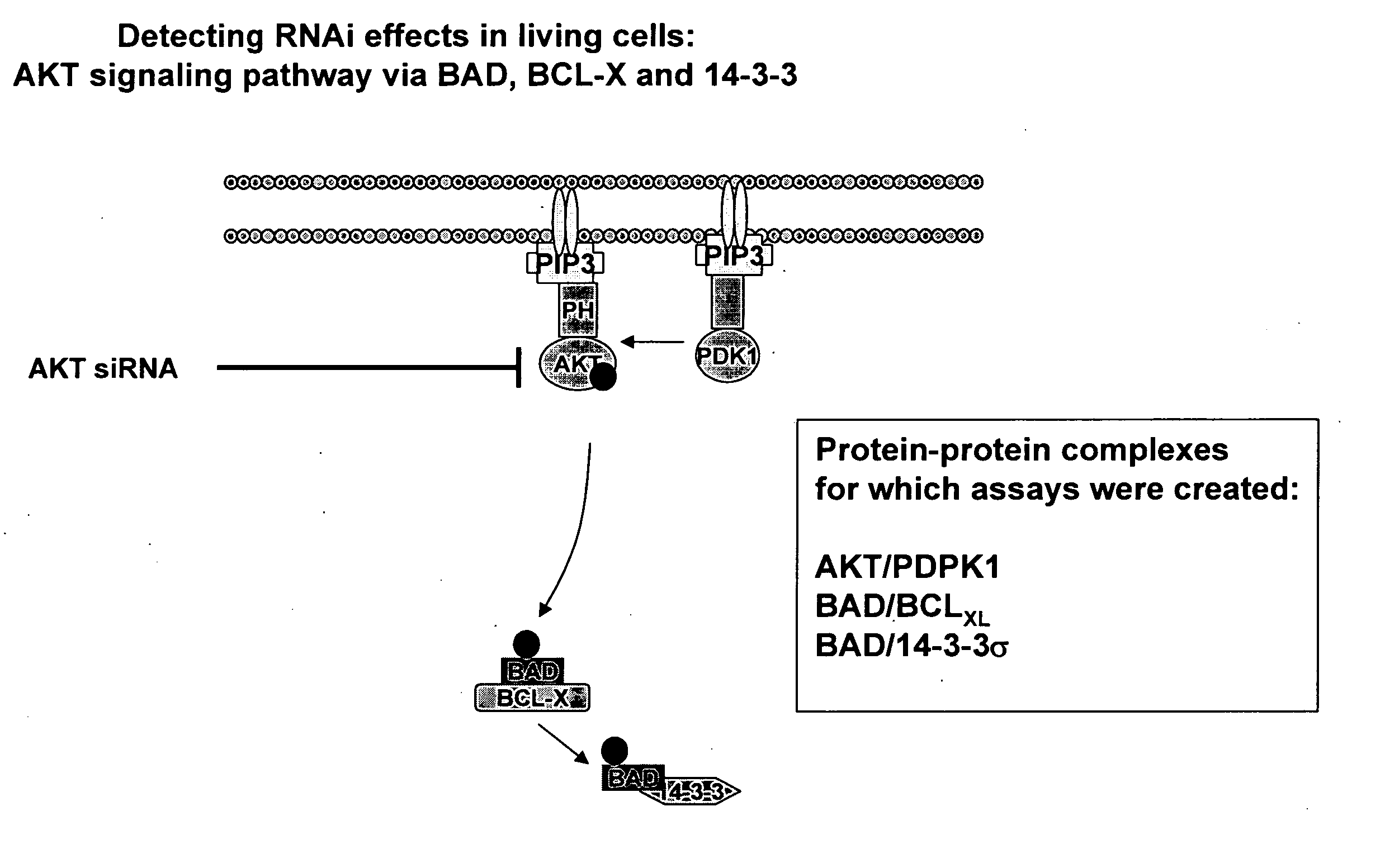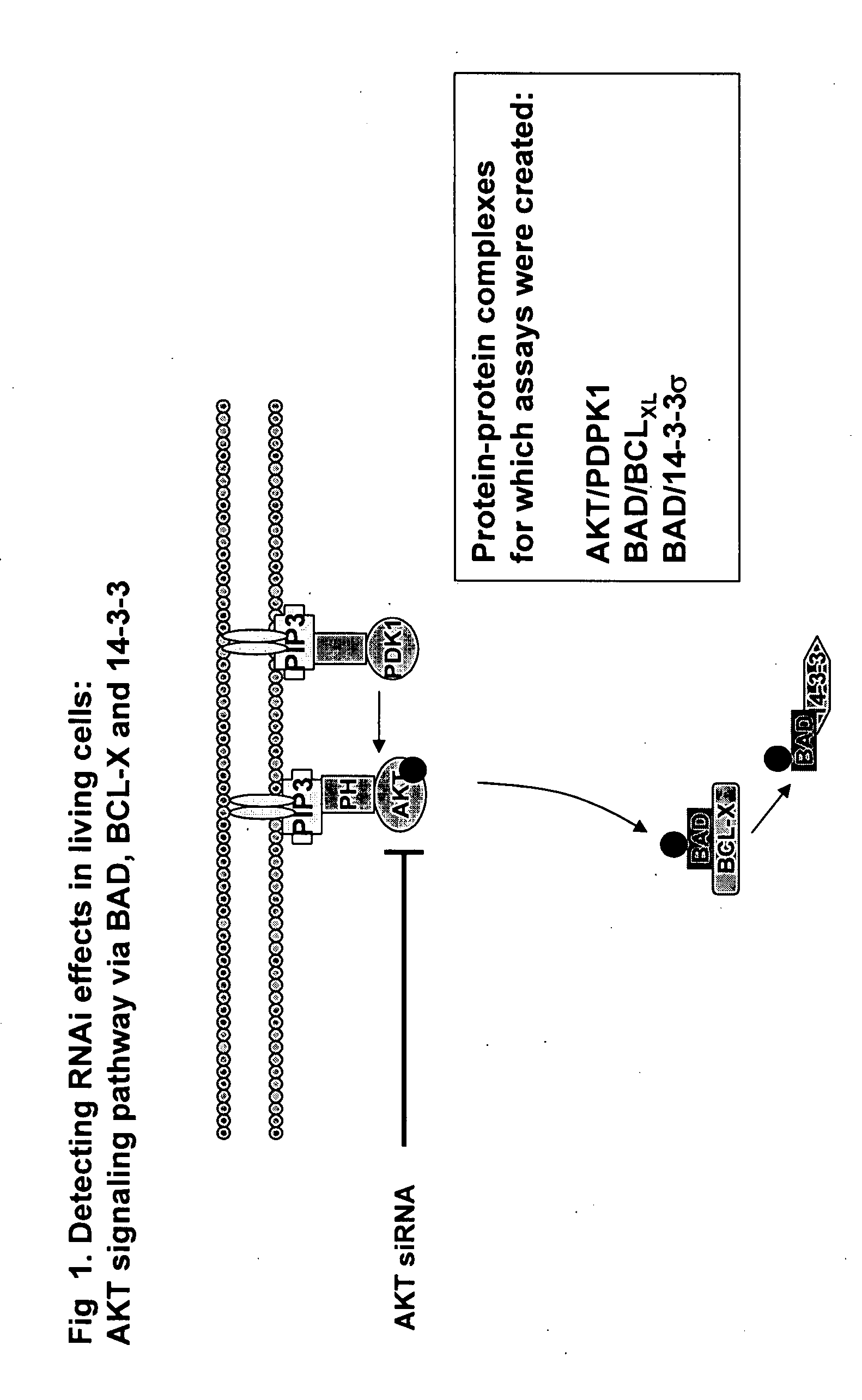Monitoring gene silencing and annotating gene function in living cells
a gene function and gene silencing technology, applied in the field of biological, molecular biology, chemistry and biochemistry, can solve the problems of not being readily adapted to large-scale studies or automated analyses of hundreds or thousands of potential drug targets, and none of the above methods can be applied to intact cells
- Summary
- Abstract
- Description
- Claims
- Application Information
AI Technical Summary
Benefits of technology
Problems solved by technology
Method used
Image
Examples
example 1
DNA Constructs
[0070] The full-length cDNAs encoding PDPK1, AKT1, BAD, BCL-xL and 14-3-3 sigma (all of which are known proteins and the corresponding full-length sequence of each is known in the art) were amplified by PCR and subcloned into a mammalian expression vector (pcDNA3.1Z, Invitrogen) which had been previously modified to contain either fragment 1 (Y1) of a yellow variant of E. victoria GFP (EYFP-F1, corresponding to GFP amino acids 1 to 158; the protein and fragment sequences being previously disclosed in commonly assigned pending U.S. application Ser. No. 10 / 772,021 filed Feb. 5, 2004) or fragment 2 (Y2) of EYFP (EYFP-F2, corresponding to GFP amino acids 159 to 239; the protein and fragment sequences being previously disclosed in commonly assigned pending U.S. application Ser. No. 10 / 724,178 filed Dec. 1, 2003). In all constructs, a 10 amino acid flexible linker consisting of glycine and serine residues [(Gly. Gly. Gly. Gly. Ser)2] such as that previously disclosed and em...
example 2
Large-Scale Mapping of Biochemical Pathways in High Throughput Formats
[0078] In mammalian cells, AKT is protected from degradation and dephosphorylation by binding to a heat shock protein (HSP90) which acts as a chaperone. HSP binding to AKT is thought to occur via the Cdc37 co-chaperone (Brazil et al., 2002). AKT present in protein complexes containing HSP90 and CDC37 was catalytically active and phosphorylated GSK3beta in vitro. HSP90 complex formation with AKT may therefore facilitate kinase activation by preventing both dephosphorylation and AKT degradation. Perturbation of this interaction, for example by ansamycin antibiotics that act as inhibitors of HSP90, or by a expressing a dominant negative form of PKB, leads to inactivation of AKT by dephosphorylation or proteasome-mediated degradation. HSP90 also stabilizes PDK1 in cells, enhancing the phorphorylation of PKB. HSP90 may also act as a scaffold protein, presenting substrates such as eNOS to PKB for phosphorylation. We us...
example 3
[0088] In a further demonstration of large-scale pathway mapping, we demonstrated the effects in human cells of an siRNA pool that silences the gene encoding the known co-chaperone protein, Cdc37.
[0089]FIG. 8 shows the results of a single annotation reagent, an optimized siRNA pool designed to silence Cdc37, against a panel of 32 assays. These assays report on diverse cellular activities. The effect of the Cdc37 siRNA (40 nM) on the fluorescence intensity of the different protein complexes (assessed by PCA) is plotted relative to the effect of a negative control siRNA. A value of 1 represents no change relative to the control. The 32 assays are represented on the x-axis, and are also listed in Table 2. Silencing of the Cdc37 gene by siRNA significantly decreased the fluorescence intensity of 8 different protein complexes in human cells, many containing proteins that are known to bind to Cdc37 (e.g. Akt1, Raf1, Chk1, etc). Representative images of the effect of siCdc37 on the Chk1:Cd...
PUM
| Property | Measurement | Unit |
|---|---|---|
| Fraction | aaaaa | aaaaa |
| Time | aaaaa | aaaaa |
| Sensitivity | aaaaa | aaaaa |
Abstract
Description
Claims
Application Information
 Login to View More
Login to View More - R&D
- Intellectual Property
- Life Sciences
- Materials
- Tech Scout
- Unparalleled Data Quality
- Higher Quality Content
- 60% Fewer Hallucinations
Browse by: Latest US Patents, China's latest patents, Technical Efficacy Thesaurus, Application Domain, Technology Topic, Popular Technical Reports.
© 2025 PatSnap. All rights reserved.Legal|Privacy policy|Modern Slavery Act Transparency Statement|Sitemap|About US| Contact US: help@patsnap.com



